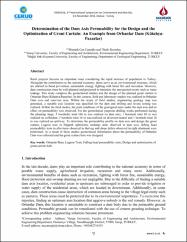Determination of the dam axis permeability for the design and the optimization of grout curtain: An example from Orhanlar dam (Kütahya-Pazarlar)
Özet
Rural projects become an important issue considering the rapid increase of population in Turkey. Alongside the contribution to the national economy, dams serve as an environmental structure, which are utilized in flood prevention, sustainable energy, fighting with forest fire and recreation. However, dam construction must be well planned and projected to minimize the unexpected events such as water leakage. This study comprise the geotechnical studies and the design of the planned grout curtain in Orhanlar Dam (Kütahya/Pazarlar). In this context, field and laboratory studies was realized in Orhanlar Dam axis and reservoir area. Within the scope of field studies, engineering geology map was generated, a suitable axis location was specified for the dam and drilling and in-situ testing was realized. Within the field studies, the joint conditions of the geological units under the dam axis and its effect on permeability was observed. For the geotechnical purposes drilling works performed during the planning stage, 5 boreholes total 166 m was realized on dam axis, 1 borehole total 10 m was realized on cofferdam, 1 borehole total 10 m was realized on diversion tunnel and 1 borehole total 10 m was realized on spillway. To determine the permeability profile on dam axis and design the grout curtain, Lugeon tests in Dagardi ophioloitic melange units observed in dam axis, falling head permeability tests in alluviums observed in thalveg and slope debris observed in right abutment were performed. As a result of these studies geotechnical information about the permeability of Orhanlar Dam was collected and the grout curtain hole was designed.


















